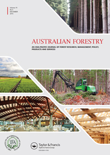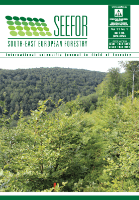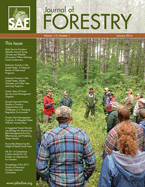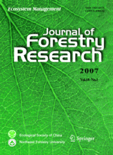
AUSTRALIAN FORESTRY
Scope & Guideline
Elevating the Discourse on Forestry Science
Introduction
Aims and Scopes
- Forest Management and Silviculture:
Research focusing on techniques and strategies for managing forest ecosystems sustainably, including silvicultural practices, growth modeling, and the impacts of various management interventions on forest health and productivity. - Ecological Restoration and Conservation:
Studies aimed at restoring degraded forest areas, enhancing biodiversity, and understanding ecological dynamics within forest ecosystems, particularly in the Australian context. - Forest Products and Utilization:
Exploration of the properties, uses, and market potential of timber and non-timber forest products, including research on wood quality, processing methods, and economic viability. - Impact of Climate Change:
Investigation into how climate change affects forest health, species distribution, and forest management practices, with a focus on adaptation strategies and mitigation efforts. - Pest and Disease Management:
Research concerning the identification, management, and impact of forest pests and diseases, including biosecurity measures and ecological implications. - Socioeconomic Aspects of Forestry:
Examination of the social and economic dimensions of forestry, including the role of forests in rural development, community engagement, and policy implications.
Trending and Emerging
- Active Forest Management Strategies:
A growing emphasis on defining and implementing active management practices in temperate forests, reflecting a shift towards adaptive management that considers ecological resilience and productivity. - Innovative Use of Technology in Forestry:
Increased interest in the application of UAVs (drones) and remote sensing technologies for monitoring and managing forest health and reforestation efforts, showcasing the integration of technology in modern forestry practices. - Climate Resilience and Adaptation Research:
A significant uptick in studies exploring how Australian forests can adapt to climate change, including the development of resilient species and management practices that mitigate the impacts of drought and extreme weather. - Sustainable Bioenergy Production:
Emerging research focused on the potential of forests as sources of renewable energy, particularly through the cultivation of specific Eucalyptus species for bioenergy, reflecting global trends in sustainability. - Social Dimensions of Forestry:
An increasing focus on the social aspects of forestry, including community involvement, gender roles in forest management, and the cultural significance of forest resources, indicating a broader understanding of forestry's impact on society.
Declining or Waning
- Traditional Timber Harvesting Techniques:
Research on conventional timber harvesting methods appears to be declining, possibly due to a growing emphasis on sustainable practices and alternative harvesting strategies that minimize ecological impacts. - Invasive Species Management:
While still relevant, the frequency of studies specifically addressing invasive species in forestry has decreased, indicating a potential shift towards integrated pest management approaches that encompass broader ecological considerations. - Static Forest Inventory Techniques:
The reliance on traditional forest inventory methods is diminishing in favor of more dynamic and technology-driven approaches, such as remote sensing and LiDAR, which provide more comprehensive data on forest conditions. - Historical Forest Management Practices:
There seems to be a waning interest in historical analyses of forest management practices, as contemporary challenges and modern methodologies take precedence in the discourse.
Similar Journals

CANADIAN JOURNAL OF FOREST RESEARCH
Connecting researchers to the heart of forest science.Canadian Journal of Forest Research (ISSN: 0045-5067, E-ISSN: 1208-6037), published by Canadian Science Publishing, stands as a leading platform for disseminating cutting-edge research in the field of forestry and ecological sciences. With an impressive impact factor and a steady reputation for high-quality publications, this journal occupies a prestigious position indicated by its Q1 ranking in Forestry and Q2 in Ecology as of 2023, alongside commendable placements in global and planetary change studies. Covering a broad scope from sustainable forest management to the impacts of climate change on forest ecosystems, the journal encourages submissions that address contemporary challenges and innovations in forest research. Operating from its base in Ottawa, Canada, the Canadian Journal of Forest Research has been a cornerstone of academic discourse since 1974, offering researchers and professionals vital access to pioneering studies that inform policy and practice in forestry. Researchers, educators, and students alike will find this journal an indispensable resource for advancing knowledge and fostering collaboration in the vital realm of forest research.

SEEFOR-South-East European Forestry
Empowering knowledge for the future of South-East European forestry.SEEFOR-South-East European Forestry is a premier open-access journal dedicated to advancing knowledge in the field of forestry and environmental science. Published by the CROATIAN FOREST RESEARCH INSTITUTE, this journal has been operational since 2010, providing a platform for research that focuses on the unique forestry dynamics of the South-East European region. With an ISSN of 1847-6481 and an E-ISSN of 1849-0891, SEEFOR is recognized for its commitment to disseminating high-quality research that addresses critical issues in forestry management, conservation, and sustainable development. The journal is indexed in Scopus, placing it within the third quartile (Q3) of forestry journals, reflecting its significance within the academic community. SEEFOR aims to connect researchers, practitioners, and policymakers, fostering collaboration and innovation in fostering sustainable forestry practices in Croatia and beyond. Submissions are welcome in a range of areas including forest ecology, policy development, and socio-economic impacts, making it an invaluable resource for professionals and students alike.

Madera y Bosques
Elevating Discourse in Wood ScienceMadera y Bosques is a prominent academic journal specializing in the fields of forestry and wood science, published by INST ECOLOGIA A C in Mexico. With an ISSN of 1405-0471 and an E-ISSN of 2448-7597, it has established itself as a vital platform for disseminating research findings, innovative practices, and methodologies pertinent to sustainable forest management and ecological conservation. Operating since 2008, the journal covers a wide scope of topics related to the complexities of forest ecosystems, the importance of biodiversity, and the challenges posed by climate change. Despite its categorization in Q4 for the year 2023 in the Forestry category, Madera y Bosques aims to elevate discourse and practice in the field, providing a voice to emerging researchers and seasoned professionals alike. Additionally, the journal adheres to open access principles, enhancing the visibility and accessibility of its articles to a global audience. Researchers and practitioners are encouraged to engage with its rich content to further their understanding and impact in the world of forestry.

BALTIC FORESTRY
Pioneering Knowledge for Sustainable Forestry PracticesBALTIC FORESTRY, published by the INST FORESTRY LRCAF in Lithuania, is a prominent academic journal that serves as a platform for disseminating cutting-edge research in the field of forestry. With an ISSN of 1392-1355, this journal is dedicated to advancing knowledge on sustainable forest management, ecological impacts, and resource conservation, among other vital topics. As of 2023, it has been categorized in the Q3 quartile for forestry in Scopus, indicating its solid reputation among peer-reviewed publications, ranking #95 out of 174 in the realm of Agricultural and Biological Sciences. BALTIC FORESTRY features contributions from researchers across the globe and encourages innovative approaches to solving contemporary challenges in forestry, making it an essential resource for professionals, scholars, and students alike. Although it operates under subscription-based access options, the journal's commitment to fostering academic discourse is unwavering, aiming to bridge the gap between theory and practice in forest science.

ANNALS OF FOREST SCIENCE
Fostering Insights into Global Environmental ChangesANNALS OF FOREST SCIENCE, published by Springer France, stands at the forefront of ecological research, contributing significantly to both the fields of Ecology and Forestry, as evidenced by its prestigious Q1 ranking in both categories for 2023. Since its inception in 1999, this journal has become an essential resource for academics, practitioners, and students who are eager to explore the complexities of forest ecosystems and their interactions with global environmental changes. With an ISSN of 1286-4560 and E-ISSN 1297-966X, it disseminates cutting-edge research and critical reviews that enhance our understanding of forest science. Although it does not offer open access, the journal continues to be a pivotal platform for presenting innovative scientific findings that address the pressing challenges of forest management and conservation. Its significant impact factor reflects the high-quality contributions that have made a lasting mark on the discipline.

EUROPEAN JOURNAL OF FOREST RESEARCH
Pioneering Research for Europe's Forest EcosystemsThe European Journal of Forest Research (ISSN: 1612-4669; E-ISSN: 1612-4677), published by Springer, stands at the forefront of advancing the field of forestry and plant sciences. With a distinguished reputation reflected in its Q1 category rankings in both Forestry and Plant Science for 2023, this journal excels in disseminating high-quality research that addresses the critical challenges facing forest ecosystems across Europe and beyond. Established in Germany, the journal has transitioned through various phases since its inception in 1996, striving to integrate innovative research findings that promote sustainable forest management and conservation strategies. As part of a rich academic tradition, it boasts a commendable ranking within the Scopus database, placing it in the top echelons of its category. Researchers and practitioners alike can benefit from its commitment to open access options, ensuring that cutting-edge studies are accessible to a global audience. The European Journal of Forest Research serves as an essential platform for knowledge exchange, aiming to enhance the understanding of forest dynamics and improve the management of forest resources in the face of a changing climate.

Revista Forestal Mesoamerica Kuru-RFMK
Exploring solutions for Central America's forest challenges.Revista Forestal Mesoamerica Kuru-RFMK is a vital academic platform dedicated to the advancement of forest science and management within the Mesoamerican region. Published by the Instituto Tecnológico de Costa Rica, this journal has been an Open Access resource since 2011, ensuring that critical research is accessible to a global audience. With an ISSN of 2215-2504, it aims to foster collaboration and knowledge exchange among researchers, professionals, and students eager to address the pressing challenges facing forests in Central America. The journal prioritizes interdisciplinary studies related to forest ecology, conservation, and sustainable management practices, making it an indispensable reference for anyone interested in enhancing forest health and biodiversity. By contributing to this resource, scholars can impact policy and practice while enriching the academic community’s understanding of Mesoamerica's unique forest ecosystems.

Central European Forestry Journal
Bridging research and practice in forestry for a greener tomorrow.Central European Forestry Journal, published by SCIENDO, is a pivotal platform dedicated to advancing research and knowledge in the field of forestry. Since its inception in 2009, this Open Access journal has provided scholars and practitioners with unrestricted access to cutting-edge research findings, promoting collaboration and innovation within the forestry community. Based in Poland, the journal serves as a crucial resource for researchers, professionals, and students alike, addressing critical topics relevant to the management, conservation, and sustainable utilization of forest resources. The journal holds a commendable Q2 ranking in Forestry, with a notable rank of 51 out of 174 and a 70th percentile in Scopus's Agricultural and Biological Sciences category. With converged publication from 2017 to 2024, the Central European Forestry Journal represents an essential avenue for disseminating knowledge and fostering dialogue in an increasingly important field.

JOURNAL OF FORESTRY
Fostering interdisciplinary collaboration for a greener future.JOURNAL OF FORESTRY, published by OXFORD UNIV PRESS INC, is a premier academic journal dedicated to advancing the field of forestry and plant sciences. With a distinguished history dating back to 1919, the journal has evolved to address contemporary challenges and innovations in these critical domains of environmental science. As evidenced by its impressive Q1 rankings in both Forestry and Plant Science categories for 2023, the journal is recognized for its contribution to scholarly research, occupying a significant position among its peers with a Scopus rank of #33 in Forestry and #122 in Plant Science. Researchers and practitioners can access the journal’s articles to stay updated on cutting-edge research, methodologies, and practices that influence sustainable forest management and conservation efforts. By fostering interdisciplinary collaboration, the JOURNAL OF FORESTRY plays a pivotal role in shaping the discourse surrounding forest ecosystems, promoting the integration of science with practice, and facilitating knowledge transfer in academia and industry. As a vital resource for researchers, professionals, and students alike, this journal serves as an essential platform for disseminating high-quality research that addresses pressing environmental concerns.

JOURNAL OF FORESTRY RESEARCH
Exploring the depths of ecological innovation.JOURNAL OF FORESTRY RESEARCH, published by Northeast Forestry University in China, stands as a pivotal platform for advancing the field of forestry science. With an ISSN of 1007-662X and an E-ISSN of 1993-0607, this esteemed journal has maintained its commitment to disseminating high-quality research since its inception in 1997, converging into a recognized authority through the years. Currently boasting a Q1 ranking in the Forestry category for 2023, it ranks 18th out of 174 journals in its field on Scopus, highlighting its vital role in shaping contemporary forestry studies. The journal focuses on a broad spectrum of topics pertinent to forestry, including sustainable forest management, ecology, and conservation efforts, making it an indispensable resource for researchers, professionals, and students alike. Although it is not an open-access publication, the insights shared within its pages promise to contribute significantly to the advancement of knowledge and practices in forestry. The journal's significant impact and relevance are underscored by its operations from Harbin, People's Republic of China, where it continues to foster scholarly communication in the world of forestry research.